449. When in late November Antares (*249)
was at the Sun, then Aldebaran had been at the Full Moon
indicating the corresponding place for people living north of
the equator, viz. early summer.
...
Antares, visible in the morning sky of December-January,
came to stand for summer heat; hence the saying, 'Rehua
cooks (ripens) all fruit'. The generally accepted
version of the Rehua myth, according to Best, is
that Rehua had two wives, the stars on either
side of Antares. One was Ruhi-te-rangi or
Pekehawani, the personification of summer languor (ruhi),
the other Whaka-onge-kai,
She-who-makes-food-scarce before the new crops can be
harvested ...
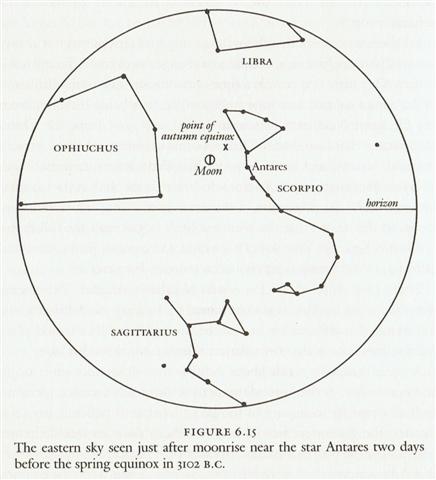
... It was
remembered (or it had been deduced) that anciently the
summer north of the equator had begun when the Sun
reached Aldebaran (α
Tauri) and ended when the Sun reached Antares (α
Scorpii).
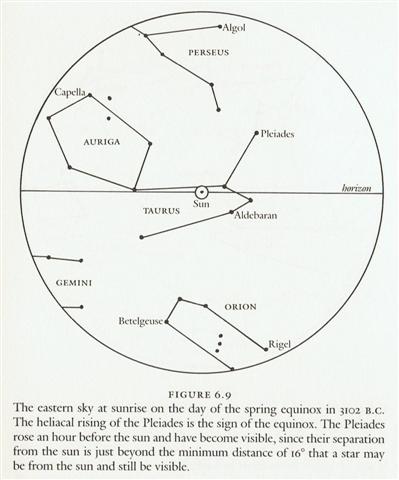
For Aldebaran the glyph type chosen by the
creator of the G text was therefore what Metoro referred
to as vaha mea (red dawn, the place for an
opening coloured as the gills of fishes)
...
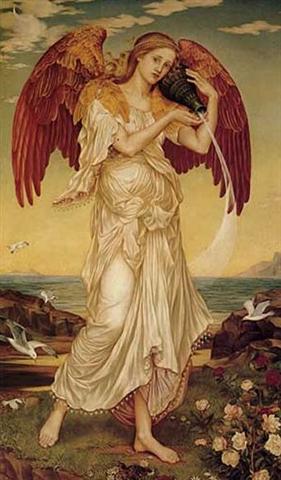
|
CLOSE TO THE SUN: |
|
0h (445 - 80 = *365) |
MARCH 22 (*1) |
23 (82) |
|
no glyph |
 |
 |
|
Ga1-1 (= 65 - 64) |
Ga1-2 |
|
HYADUM II = δ¹ Tauri
(64.2) |
Net-19 (Crow)
AIN (Eye) =
ε
Tauri,
θ¹ Tauri, θ² Tauri (65.7) |
no star listed (66) |
 |
|
May 24 |
25 (145 = 290 /
2) |
26 (*66) |
|
'April 27 |
28 (118 = 4 * 29½) |
29 (*39) |
|
"April 13 |
14 (104 = 8 * 13) |
15 (*25) |
|
CLOSE TO THE SUN: |
|
MARCH 24 |
JULIAN EQUINOX |
26 (*5) |
27 |
 |
 |
 |
 |
|
Ga1-3 |
Ga1-4 |
Ga1-5 |
Ga1-6 |
|
no star listed (67) |
Rohini-4 (The Red One) / Pidnu-sha-Shame-4 (Furrow of Heaven) / ANA-MURI-2 (Rear pillar - at the foot of which was the place for tattooing)
ALDEBARAN = α Tauri (68.2), THEEMIN = υ² Eridani (68.5) |
no star listed (69) |
no star listed (70) |
|
May 27 |
28 (148) |
29 |
30 (*70) |
|
°May 23 |
24 (144) |
25 (*65) |
26 |
|
'April 30 |
'May 1 (121) |
2 (*42) |
3 |
|
16 (471) |
"April 17 (107) |
18 (*28) |
19 |
|
Itzam-Yeh (7-Macaw, Ursa Major)
defeated |
28 May, 3149 BC (148) |
|
First 3-stone place |
21 May, 3114 BC (141) |
|
Creation of our present world |
13 Aug, 3114 BC (225) |
|
Hun-Nal-Ye became the sky |
5 Febr, 3112 BC (36) |
|
21 May, 3114 BC - 13 August,
3114 BC = 225 - 141 = 84 (= 12 * 7)
21 May, 3114 BC -
5
February, 3112 BC =
542, which
'happens to be' the sum of 365 days
and 6 * 29½ nights.
At the time of rongorongo the day
May 28 (148, *68) was where
Aldebaran rose with the Sun and 77
days later, in August 13 (225, *145)
the Sun had reached the Knot (Ukdah)
with the Full Moon at the Foundation
(Bunda).
 |
|
But when in late May Aldebaran (*68) was at
the Sun, it meant the dark season, 'the'year in straw', had arrived for
people south of the equator because Antares was then at the
Full Moon. May 28 was a place at the rear for the black marks of
tattooing:
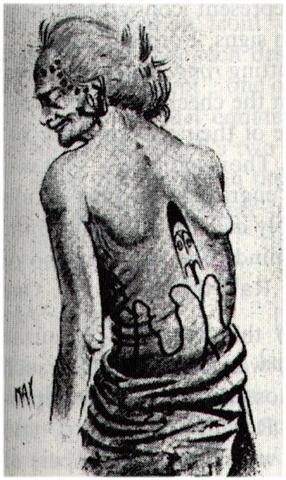
 |
 |
 |
 |
| Ca3-17 (84 - 16 = 68) |
Ca3-18 (69) |
Ca3-19 |
Ca3-20 → Dramasa |
| tapamea - tagata rima iri |
te henua te hokohuki |
te kava |
te kiore i te henua |
|
CLOSE TO THE FULL MOON: |
|
May 28 (148)
Rohini-4 (The Red One) / Pidnu-sha-Shame-4 (Furrow of Heaven) / ANA-MURI-2 (Rear pillar - at the foot of which was the place for tattooing)
ALDEBARAN = α Tauri (68.2), THEEMIN = υ² Eridani (68.5) |
29 no star listed (69) |
30 (→ 5 * 30 = 150) no star listed (70) |
31 TABIT = π³ Orionis (71.7), π² Orionis (71.9) 320 (South Pole star, Dramasa) - 71 (Tabit) = 249 (Antares) |
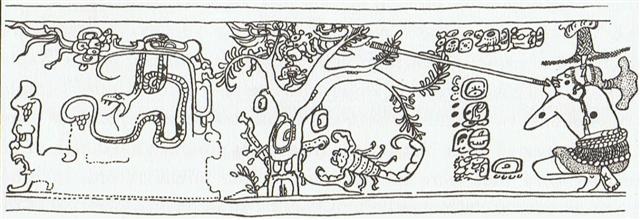 ... This pot depicts one of the Hero Twins (One-Ahaw in the Classic texts and One-Hunaphu in the K'iche' Popol Vuh) and a great bird who is trying to land in a huge ceiba tree heavy with fruit. This mythical bird is Itzam-Yeh, Classic prototype of Wuqub-Kaqix, 'Seven-Macaw', of Popol Vuh fame. In that story, in the time before the sky was lifted up to make room for the light, the vainglorious Seven-Macaw imagined himself to be the sun. Offended by his pride, the Hero Twins humbled him by breaking his beautiful shining tooth with a pellet from their blowgun. This pot shows One-Ahaw aiming at the bird as he swoops down to land in his tree. As Itzam-Yeh lands on his perch, the text tells us he is 'entering or becoming the sky'. This particular 'sky-entering' is not the one mentioned in the Palenque text. It is the final event that occurred in the previous creation before the universe was remade. Before the sky could be raised and the real sun revealed in all its splendor, the Hero Twins had to put the false sun, Itzam-Yeh, in his place. If the date on this pot corresponds to that pre-Creation event, as we believe it does, then Itzam-Yeh was defeated in 12.18.4.5.0 1 Ahaw 3 K'ank'in (May 28, 3149 B.C.) ... |
| CLOSE TO THE SUN: |
| Nov 27 (148 + 183) HAN = ζ Ophiuchi (251.0) |
28 (332 = 149 + 183) ζ Herculis, η Tr. Austr. (252.1), η Herculis, β Apodis (252.5) |
29 (300 + 33) ATRIA = α Tr. Austr. (253.9) |
30 (*254 = *71 + *183) Tail-6 (Tiger)
WEI (Tail) = ε Scorpii, η Arae (254.3), DENEBAKRAB = μ Scorpii (254.7) |
 |
If we can equate mulApin (Triangulum) with the Easter Island location Apina Nui, then we could guess Apina Iti was the Southern Triangle.
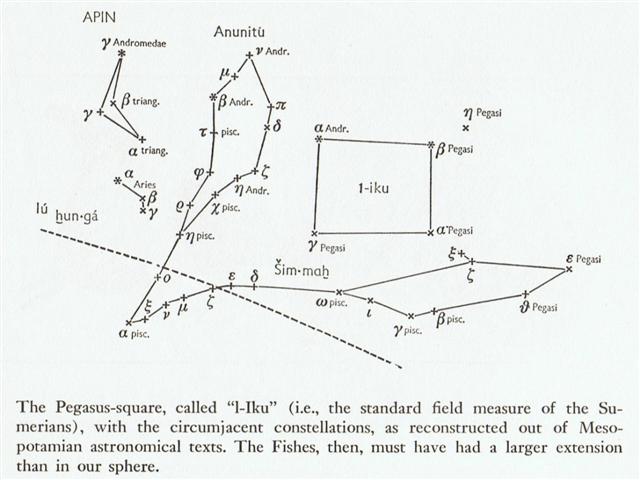
... You are the one who shall stay here. We, on the other hand, have to turn around. Makoi replied, All right with me! Then Ira continued to speak to Makoi: Tomorrow, when it grows light, set out and name the places beginning with Apina. Makoi replied, How shall I give the names? Again Ira spoke, In Hiva are the names that are to be taken to name (the places of the new land). It grew light and Makoi got up. He set out and came to Apina. When he arrived there, he gave the name This is Apina Iti, this is Rapa Kura. He went on and came to Hanga O Ua. He gave the name This is Hanga O Ua of the Beautiful Wave (vave renga). Makoi went on, giving names, until he had made a (complete) circle around both sides (of the island). In Apina Nui a stone (maea) was erected, saying that the naming was done on a (round) trip during a single day ... However, Makoi had been ordered to give place names according to the customs in Hiva and therefore it was probable that Apina Iti did not refer to the Southern Triangle but rather to Triangulum Minus:
 Allen: "Its titles [Triangulum] Sicilia, Trinacria, and Triquetra, are those of the ancients for the similarly shaped island of Sicily, - that Ceres had begged of Jove might be reproduced in the sky, - triangular from its three promontories, Lilybaeum, Pelorus, and Pachynus, and at times identified with the mythical Thrinakia of the Odyssey, the pasture-ground of the Oxen of the Sun, that Gower called Mela's Holy Ox-land. In modern days it has been noted as the site of the famous Palermo Observatory. It was here that was discovered by Piazzi, on the first New Year's Day of the present century [1 January, 1800 AD], the first minor planet, which he named Ceres Ferdinandea in joint honor of the patron goddess of the island and of his king, the Bourbon Ferdinand of Naples; but the adjective has been dropped by astronomers as not conforming to their rule of mythological nomenclature for the planets, - a rule, however, much deviated from in recent times in the naming of these little bodies. Perhaps the astronomers have exhausted their classical dictionaries! It was found¹ as an 8th magnitude star - Flammarion says a comet - between Aries and Taurus, coincidently not far from our Triangulum, the ancient Sicilia; but it was little imagined at the time that 433 similar bodies would be found in the next ninety-seven years ... ¹ This, like many other important discoveries, was by a happy accident, - Piazzi, very differently, being in search of an extra star, the eighty-seventh of Mayer's list, wrongly laid down in Wollaston's catalogue." The Easter Islanders could have identified also their island as corresponding to the pasture-ground of the Oxen of the Sun because of the similarity in shape: 
... He continued travelling until he reached the house of Uetonga, whose name all men know: he was the tattoo expert of the world below, and the origin and source of all the tattoo designs in this world. Uetonga was at work tattooing the face of a chief. This chief was lying on the ground with his hands clenched and his toes twitching while the father of Niwareka worked at his face with a bone of many sharpened points, and Mataora was greatly surprised to see that blood was flowing from the cheeks of that chief. Mataora had his own moko, it was done here in the world above, but it was painted on with ochre and blue clay. Mataora had not seen such moko as Uetonga was making, and he said to him, 'You are doing that in the wrong way, O old one. We do not do it thus.' 'Quite so,' replied Uetonga, 'you do not do it thus. But yours is the way that is wrong. What you do above there is tuhi, it is only fit for wood. You see,' he said, putting forth his hand to Mataora's cheek, 'it will rub off.' And Uetonga smeared Mataora's make-up with his fingers and spoiled its appearance. And all the people sitting round them laughed, and Uetonga with them ...
The designs that were made on Mataora's face by the chisel of Uetonga were the tiwhana, these lines that sweep over the eyebrows to the temples; the rerepehi, those lines which sweep from the nose around the mouth to the chin; and also the two spirals on the side of the nose of a man, they are called ngu and pongiangia. We call this work moko because of the lizard whose twitching tail is seen in all its curving lines ...

The first station on Makoi's list was Apina Iti (as described on page 38 of Manuscript E) and the map of Metoro identifies this place with the promontory named pta Roa on the map of Captain Cook:
Roa. Long: haga roa, long bay, wide beach; ara roa râkei, wide, neat path. Roaroa, long, tall, far, distant: tagata roaroa, tall man; kaiga roaroa, distant land; roaroa tahaga, middle finger. Vanaga. Long, large, extent; roaroa, to grow, height; mea roaroa, a long while; roaroa tahaga, middle finger; roaroa ke, infinite (time and space); roroa, far, distant, thin, to grow tall; tagata roroa, giant; roroa ke, immense; arero roroa, to rapport, to tell; vanaga roroa, to chatter, babbler; vare roroa, driveller; hakaroa, to lengthen, to defer; hakaroaroa, to lengthen, to develop; hakaroroa, to extend, prolong, defer, lengthen; roaga, distance, extent, size, length, distant, long. Churchill.
|
38) |
|
1 |
ko apina iti.ko rapa kura.he oho mai he |
|
2 |
tuu ki hanga o uo.he nape i te ingoa.ko hanga o uo |
|
|
a vave renga. |
|
|
he nape he oho a Makoi .i te ingoa.ka vari ro. |
|
|
a arurua.aro i apina nui i hakatuu ai |
|
|
te maea.etahi no raa.i nape i oho ai. |
|
3 |
hanga roa a tuki tukau |
|
4 |
Okahu a uka ui hetuu. |
|
5 |
ra tahai a uo. |
|
6 |
ahu akapu a mata kurakura. |
|
7 |
kihikihi rau mea a rapa rau renga |
|
8 |
renga a tini a toto renga |
|
9 |
vai a mei u(h)i kapokapo. |
|
10 |
rua a ngau a nua ngirongiro. |
|
11 |
roro hau a mana ai rea. |
|
12 |
vai poko aa raa mata turu |
|
13 |
ko te hereke a kino ariki |
.jpg)
In short:
|
1 |
apina iti |
4 |
Okahu |
Kahu. Clothing, dress, habit, cloth, curtain, vestment, veil, shirt, sheet; kahu hakaviri, shroud; kahu nui, gown; rima o te kahu, sleeve; kahu rahirahi, muslin; hare kahi, tent; horega kahu, shirt; hakarivariva ki te kahu, toilet; rakai ki te kahu, toilet; patu ki te kahu, to undress; kahu oruga, royal sail; kahu hakatepetepe, jib; kahu nui, foresail; hakatopa ki te kahu, to set sail; (hecki keho, canvas T.) P Pau.: kahu, dress, garment, native cloth. Mgv.: kahu, cloth, stuff, garment, clothing. Mq.: kahu, habit, vestment, stuff, tunic. Ta.: ahu, cloth in general, vestment, mantle. Chuchill. |
|
2 |
hanga o uo |
5 |
ra tahai |
|
6 |
ahu akapu |
|
7 |
kihikihi rau mea |
|
8 |
renga a tini |
|
9 |
vai a mei |
|
3 |
hanga roa |
10 |
rua a ngau |
|
|
11 |
roro hau |
|
12 |
vai poko |
|
13 |
re hereke |
Ahu Akapu was as a pair of days for resting, we should remember, and possibly Okahu (4) referred to day 378 at heliacal Vindemiatrix. The following glyph is of the type raaraa (central ceremonial ground) and this would then correspond to Ra Tahai - the day (ra) of Cook pt.
| JUNE 1 (178 - 26) |
2 (336 - 183) |
3 (154) |
4 (*85) |
5 |
6 |
| JULY 28 |
29 (7 * 30) |
30 (211 = 275 - 64) |
31 (212 = 155 + 57) |
AUG 1 |
2 (214 = 237 - 23) |
 |
 |
 |
 |
 |
 |
| *Ca14-12 |
*Ca14-13 |
*Ca14-14 |
*Ca14-15 (378 → Saturn) |
*Ca14-16 |
*Ca14-17 |
| te kihikihi |
o te henua - kua haga hia |
kua pua |
te vero |
te henua |
kiore - te henua |
| CLOSE TO THE SUN: |
| no star listed (193)
*152 = *178 - *26 |
κ Crucis (194.4), ψ Virginis (194.5), μ Crucis, λ Crucis (194.6), ALIOTH (Fat Tail) = ε Ursae Majoris, ι Oct. (194.8) *153 = *194.4 - *41.4 |
MINELAUVA = δ Virginis (195.1), COR CAROLI = α Canum Ven. (195.3) |
δ Muscae (196.5) , VINDEMIATRIX (Grape Gatherer) = ε Virginis (196.8) *85 + *68 = *155 |
13h (197.8)
ξ¹ Centauri (197.1), ξ² Centauri (197.9 |
APAMI-ATSA (Child of Waters) = θ Virginis, ψ Hydrae (198.5), DIADEM = α Com. Ber. (198.9) |
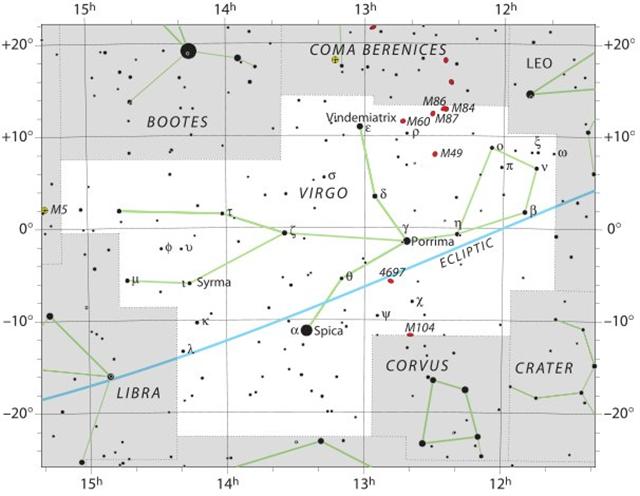 |
| Sept 30 |
Oct 1 |
2 (275 = 92 + 183) |
3 |
4 |
5 |
| Hora Iti 20 |
"Aug 21 (233) |
22 (275 - 41) |
23 |
24 (8 * 29½) |
25 |
| PAPA O PEA |
AHU AKAPU |
|
... He (i.e., Ira) said, 'Let's go! We shall go to Papa O Pea'. They all got up and moved on. On the twentieth day of the month of August ('Hora Iti') they went to Papa O Pea. They all went and came to Papa O Pea, looked around in Papa O Pea, and gave the name 'Papa O Pea A Hau Maka'. They stayed five days in Papa O Pea ...
Pea. (Also peapea): To go away with bits of food or mud sticking to one's face or garments. Vanaga. Peaha, perhaps ... maybe, chance, doubtful; reoreo peaha ... Ma.: pea, perhaps. Peapea, an erasure ... hakapeapea ... Peau, to sweep all away. Ma.: peau, to be turned away. Churchill. Peau, a wave (Sa., To., Fu., Fotuna, Niuē, Mq., Nuguria); Mgv.: peau, peahu, id. Churchill 2.
... But in the fullness of time an obscure instinct led the eldest of them towards the anthill which had been occupied by the Nummo. He wore on his head a head-dress and to protect him from the sun, the wooden bowl he used for his food. He put his two feet into the opening of the anthill, that is of the earth's womb, and sank in slowly as if for a parturition a tergo. The whole of him thus entered into the earth, and his head itself disappeared. But he left on the ground, as evidence of his passage into that world, the bowl which had caught on the edges of the opening. All that remained on the anthill was the round wooden bowl, still bearing traces of the food and the finger-prints of its vanished owner, symbol of his body and of his human nature, as, in the animal world, is the skin which a reptile has shed ...
They made camp and rested at Ahu Akapu for two days ... |
| CLOSE TO THE FULL MOON: |
| March 30 |
31 (90 = 80 + 10) |
April 1 (*377) |
2 |
3 (459 = 93 + 366) |
4 (94) |
|
To throw, to hurl (a lance, a spear). This word was also used with the particle kua preposed: koía kua vero i te matá, he is the one who threw the obsidian [weapon]. Verovero, to throw, to hurl repeatedly, quickly (iterative of vero). Vanaga. 1. Arrow, dart, harpoon, lance, spear, nail, to lacerate, to transpierce (veo). P Mgv.: vero, to dart, to throw a lance, the tail; verovero, ray, beam, tentacle. Mq.: veó, dart, lance, harpoon, tail, horn. Ta.: vero, dart, lance. 2. To turn over face down. 3. Ta.: verovero, to twinkle like the stars. Ha.: welowelo, the light of a firebrand thrown into the air. 4. Mq.: veo, tenth month of the lunar year. Ha.: welo, a month (about April). Churchill. Sa.: velo, to cast a spear or dart, to spear. To.: velo, to dart. Fu.: velo, velosi, to lance. Uvea: velo, to cast; impulse, incitement. Niuē: velo, to throw a spear or dart. Ma.: wero, to stab, to pierce, to spear. Ta.: vero, to dart or throw a spear. Mg.: vero, to pierce, to lance. Mgv.: vero, to lance, to throw a spear. Mq.: veo, to lance, to throw a spear. Churchill 2. WELO, v. Haw., to float or stream in the wind; to flutter or shake in the wind, s. the setting of the sun, or the appearance of it floating on the ocean; welo-welo, colours or cloth streaming in the wind, a tail, as of a kite, light streaming from a brand of fire thrown into the air in the dark; hoku-welo-welo, a comet, a meteor; ko-welo, to drag behind, as the trail of a garment, to stream, as a flag or pennant. Sam., Tong., welo, to dart, cast a spear of dart. Tah., wero, to dart, throw a spear; a storm, tempest, fig. great rage; wero-wero, to twinkle, as the stars. Marqu., weo, a tail. Mangar., wero, a lance, spear. Greek, βαλλω, εβαλον, to throw, cast, hurl, of missiles, throw out, let fall, push forward; βελος, a missile, a dart; βελεμνον, id., βολη, a throw, a stroke; βολος, anything thrown, missile, javelin, a cast of the dice. Sanskr., pal, to go, to move. To this Benfey refers the Lat. pello, Greek παλλω, O. H. Germ. fallan, A.-Sax. feallan. Liddell and Scott are silent on these connections. (Fornander)
... A vestige of the practice of putting the king to death at the end of a year's reign appears to have survived in the festival called Macahity, which used to be celebrated in Hawaii during the last month of the year. About a hundred years ago a Russian voyager described the custom as follows: 'The taboo Macahity is not unlike to our festival of Christmas. It continues a whole month, during which the people amuse themselves with dances, plays, and sham-fights of every kind. The king must open this festival wherever he is. On this occasion his majesty dresses himself in his richest cloak and helmet, and is paddled in a canoe along the shore, followed sometimes by many of his subjects. He embarks early, and must finish his excursion at sunrise. The strongest and most expert of the warriors is chosen to receive him on his landing. The warrior watches the canoe along the beach; and as soon as the king lands, and has thrown off his cloak, he darts his spear at him, from a distance of about thirty paces, and the king must either catch the spear in his hand, or suffer from it: there is no jesting in the business. Having caught it, he carries it under his arm, with the sharp end downwards, into the temple or heavoo. On his entrance, the assembled multitude begin their sham-fights, and immediately the air is obscured by clouds of spears, made for the occasion with blunted ends. Hamamea (the king) has been frequently advised to abolish this ridiculous ceremony, in which he risks his life every year; but to no effect. His answer always is, that he is as able to catch a spear as any one on the island is to throw it at him. During the Macahity, all punishments are remitted throughout the country; and no person can leave the place in which he commences these holidays, let the affair be ever so important ... |
| "Febr 17 |
18 (49 = 90 - 41) |
19 (*336) |
20 |
21 (418 = 459 - 41) |
22 |
|
ξ Phoenicis (9.0), ρ Tucanae (9.1), DENEB KAITOS (Tail of the Sea Beast) = β Ceti, η Phoenicis (9.4), AL NITHĀM (String of Pearls) = φ¹ Ceti (9.6)
*334 = *375.4 - *41.4 |
ACHIRD (Woman with Luminous Rays) = η Cassiopeiae (10.7) |
Legs-15 (Wolf)
ν Andromedae (11.0), φ² Ceti (11.1), ρ Phoenicis (11.2), η Andromedae (11.4)
*336 = *377.4 - *41.4 |
CIH (Whip) = γ Cassiopeiae, λ Tucanae (12.4), φ³ Ceti (12.6), μ Andromedae (12.8) *12.4 + *366 -*41.4 = *337 |
φ4 Ceti (13.2) |
no star listed (14) |
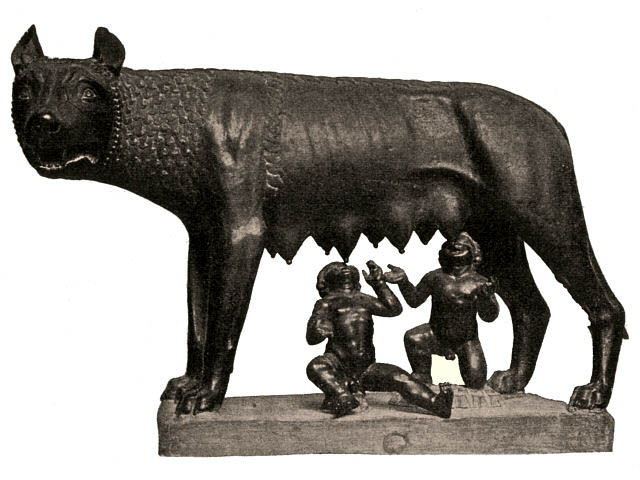 |
| JAN 25 |
26 (= 90 - 64) |
27 (393 = 366 + 27) |
(*378 - *64 = *314) |
29 |
30 (460 - 64 = 396) |
| DEC 1 |
2 (336) |
3 |
4 (*314 - *56 = *258) |
5 |
6 (*260 = *380 - *120) |
|

















.jpg)




